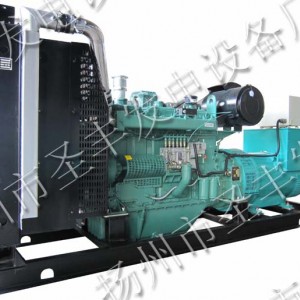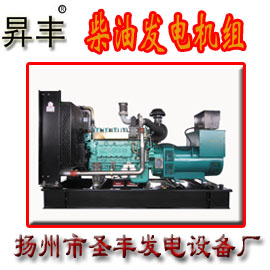二.什么叫發(fā)電機(jī)組的準(zhǔn)同期并列法?怎樣進(jìn)行同期并列?準(zhǔn)同期就是準(zhǔn)確周期。用準(zhǔn)同期法進(jìn)行并列操作,發(fā)電機(jī)組電壓必須相同,頻率相同以及相位一致,這可通過裝在同期盤上的兩塊電壓表、兩塊頻率表以及同期表和非同期指示燈來監(jiān)視,并列操作步驟如下:
將其中一臺(tái)發(fā)電機(jī)組的負(fù)荷開關(guān)合上,將電壓送至母線上,而另一臺(tái)機(jī)組處在待并狀態(tài)。合上同期開頭,調(diào)節(jié)待并發(fā)電機(jī)組的轉(zhuǎn)速,使它等于或接近同步轉(zhuǎn)速(與另一臺(tái)機(jī)組的頻率相差在半個(gè)周波以內(nèi)),調(diào)節(jié)待并發(fā)電機(jī)組的電壓,使其與另一臺(tái)發(fā)電機(jī)組電壓接近,在頻率與電壓均相近時(shí),同期表的旋轉(zhuǎn)速度是越來越慢的,同期指示燈也時(shí)亮?xí)r暗;當(dāng)待并機(jī)組與另一臺(tái)機(jī)組相位相同時(shí),同期表指針指示向上方正中間位置,同期燈最暗,當(dāng)待并機(jī)組與另一臺(tái)機(jī)組相位差最大時(shí),同期表指向下方正中位置,此時(shí)同期燈最亮,當(dāng)同期表指針按順時(shí)針方向旋轉(zhuǎn)時(shí),這說明待并發(fā)電機(jī)的頻率比另一臺(tái)機(jī)組的頻率高,應(yīng)降低待并發(fā)電機(jī)組的轉(zhuǎn)速,反之當(dāng)同期表指針按逆時(shí)針方向旋轉(zhuǎn)時(shí),應(yīng)增加待并發(fā)電機(jī)組的轉(zhuǎn)速。當(dāng)同期表指針順時(shí)針方向緩慢旋轉(zhuǎn),指針接近同期點(diǎn)時(shí),立即將待并機(jī)組的斷路器合閘,使兩臺(tái)發(fā)電機(jī)組并列。并列后切除同期表開關(guān)和相關(guān)的同期開關(guān)。
三.在進(jìn)行發(fā)電機(jī)組的準(zhǔn)同期并列時(shí),應(yīng)注意什么?準(zhǔn)同期并列是手動(dòng)操作,操作是否順利與運(yùn)行人員的經(jīng)驗(yàn)有很大的關(guān)系,為防止不同期并列,下列三種情況不準(zhǔn)合閘。1. 當(dāng)同期表指針出現(xiàn)跳動(dòng)現(xiàn)象時(shí),不準(zhǔn)合閘,因?yàn)橥诒韮?nèi)部可能有卡帶現(xiàn)象,反映不出正確的并列條件。 2. 當(dāng)同期表旋轉(zhuǎn)過快時(shí),說明待并發(fā)電機(jī)組與另一臺(tái)發(fā)電機(jī) 組的頻率相差太大,由于斷路器的合閘時(shí)間難以掌握,往往使斷路器不在同期點(diǎn)合閘,所以此時(shí)不準(zhǔn)合閘。3. 如果同期表指針停在同期點(diǎn)上不動(dòng),止時(shí)不準(zhǔn)合閘。這是因?yàn)閿嗦菲髟诤祥l過程中如果其中一臺(tái)發(fā)電機(jī)組的頻率突然變動(dòng),就有可能使斷路器正好合在非同期點(diǎn)上。
四.怎樣調(diào)整并列機(jī)組的逆功現(xiàn)象?
當(dāng)兩臺(tái)發(fā)電機(jī)組空載并列后,會(huì)在兩臺(tái)機(jī)組之間,產(chǎn)生一個(gè)頻率差與電壓差的問題。并且在兩臺(tái)機(jī)組的監(jiān)視儀表上(電流表、功率表、功率因數(shù)表),反應(yīng)出實(shí)際的逆功情況,一種是轉(zhuǎn)速(頻率)不一致造成的逆功,另一種是電壓不等造成的逆功,其調(diào)整如下:
1.頻率造成逆功現(xiàn)象的調(diào)整: 如果兩臺(tái)機(jī)組的頻率不等,相差較大時(shí),在儀表上(電流表、功
表)顯示出,轉(zhuǎn)速高的機(jī)組電流顯示正值,功率表指示為正功率,反之,電流指示負(fù)值,功率指示負(fù)值。這時(shí)調(diào)整其中一臺(tái)機(jī)組的轉(zhuǎn)速(頻率),視功率表的指示進(jìn)行調(diào)整,把功率表的指示調(diào)整為零即可。使兩臺(tái)機(jī)組的功率指示均為零,這樣兩臺(tái)機(jī)的轉(zhuǎn)速(頻率)基本上一致。但是,這時(shí)電流表仍有指示時(shí),這就是電壓差造成的逆功現(xiàn)象了。
2,電壓差造成逆功現(xiàn)象的調(diào)整: 當(dāng)兩臺(tái)機(jī)組的功率表指示均為零時(shí),而電流表仍然有電流指示(即一反一正指示)時(shí),可調(diào)整其中一臺(tái)發(fā)電機(jī)組的電壓調(diào)整旋鈕,調(diào)整時(shí),視電流表與功率因數(shù)的指示進(jìn)行。將電流表的指示消除(即調(diào)整為零),電流表無指示后,這時(shí)視功率因數(shù)表的指示,把功率因數(shù)調(diào)至滯后0.5以上即可.一般可調(diào)整至0.8左右,為最佳狀態(tài)。
五、發(fā)電機(jī)保護(hù)回路
1.逆功 逆功現(xiàn)象是由發(fā)電機(jī)組轉(zhuǎn)速(頻率)及電壓不同而造成的,即一臺(tái)發(fā)電機(jī)組帶正功,而另一臺(tái)機(jī)組帶負(fù)功率。也就是說帶負(fù)功率的機(jī)組,這時(shí)變成了一個(gè)負(fù)載(此機(jī)組頻率低,轉(zhuǎn)速不一致的現(xiàn)象)。電壓不相同時(shí),電壓高的機(jī)組,向電壓低的機(jī)組,提供一個(gè)無功電流與無功電壓(此機(jī)組的電流表正向指示),相當(dāng)于在本供電系統(tǒng)內(nèi),加了一個(gè)調(diào)相機(jī)組。電壓低的機(jī)組,這時(shí)成為一個(gè)大的負(fù)載,接受一個(gè)很大的無功電流,來維持兩臺(tái)機(jī)組的電壓平衡(此機(jī)組的電流表反向指示)。監(jiān)測(cè)時(shí)把某一臺(tái)機(jī)組的電壓調(diào)高,或?qū)⒘硪慌_(tái)機(jī)組電壓高低,造成一臺(tái)機(jī)組有逆功電流,其動(dòng)作電流為額定電流20%左右。逆動(dòng)繼電器動(dòng)作、跳閘、報(bào)警,但不停機(jī)。
2.過電流: 現(xiàn)在的發(fā)電機(jī)組額定功率一定的,它的超載能力很低,基本上在額定功率的5%左右,允許帶載時(shí)間15~30分鐘,最多不超60分鐘,超過這個(gè)時(shí)間,發(fā)電機(jī)組會(huì)發(fā)熱,導(dǎo)線絕緣會(huì)降低,也就降低了使用壽命。所以在設(shè)定過電流保護(hù)時(shí)無特殊要求的,過電流保護(hù)設(shè)定在額定電流的110%即可。帶載測(cè)試時(shí),將電流帶至額定流的110%,過流繼電器動(dòng)作。跳閘、報(bào)警、不停機(jī)。
3.過電壓: 在并列使用發(fā)電機(jī)組時(shí)最怕供電系統(tǒng)發(fā)生振蕩,一但發(fā)生振蕩系統(tǒng)電壓升高,易造成用電設(shè)備及供電設(shè)備的絕緣擊穿,使供電設(shè)備與用電設(shè)備一起癱瘓。為此并列使用的發(fā)電機(jī)組均裝有過電壓保護(hù),其設(shè)定值為額定電壓的105%為最佳。短接過電壓繼電器,跳閘停機(jī)、報(bào)警動(dòng)作 .
六、分合閘回路分、合閘回路均接入手機(jī)并列,自動(dòng)并列的控制回路。
1. 手動(dòng)分合閘:每臺(tái)機(jī)組均可做為首機(jī)或待并分、合閘使用,在手動(dòng)并車或供電時(shí),使用手動(dòng)分合閘。
2. 自動(dòng)分合閘:每臺(tái)機(jī)組均可選擇為待并機(jī)組,或首臺(tái)機(jī)組;首機(jī)機(jī)組自啟動(dòng)后,合閘回路自動(dòng)合閘,自動(dòng)投入及退出同期。同期后把待并機(jī)組自動(dòng)合閘并列運(yùn)行。
3. 無論是手動(dòng)合閘,還是自動(dòng)合閘,一旦機(jī)組出現(xiàn)逆功,過了低油壓、高水溫、高水溫、高油溫、過電壓,全部自動(dòng)分閘解列與負(fù)載脫離。
七、同期回路
1. 當(dāng)首機(jī)合閘后把電源送至母線,這時(shí)母線檢測(cè)同期回路,與待并機(jī)的同期回路,接到信號(hào)后,自動(dòng)合上同期檢測(cè)繼電器。將母線電壓與待并機(jī)電壓送至同期控制模塊,模塊自動(dòng)檢測(cè),并列機(jī)組的電壓與轉(zhuǎn)速。如果轉(zhuǎn)速有差別時(shí),同期模塊自動(dòng)調(diào)整待并機(jī)轉(zhuǎn)速,使其達(dá)到并列條件。找到同期點(diǎn)后同期模塊發(fā)出合閘指令,待并機(jī)組接到指令后執(zhí)行合閘,即兩臺(tái)機(jī)組并列運(yùn)行。
2. 機(jī)組并列后,同期回路自動(dòng)退出工作狀態(tài),但必須人為的把自動(dòng)同期的轉(zhuǎn)換開關(guān)退出,防止來電后在解列時(shí),待并機(jī)組又接到并列信號(hào),將同期裝置自動(dòng)投入,使機(jī)組再次并列。
八、負(fù)載分配
1. 單機(jī)運(yùn)行時(shí),負(fù)載分配器不投入工作。
2. 機(jī)組并列后每臺(tái)機(jī)組的負(fù)載分配器,同時(shí)投入工作,各自調(diào)整自已的轉(zhuǎn)速,使其兩臺(tái)機(jī)組的功率平均分配,其工作原理,就是根據(jù)本機(jī)組的輸出功率的大小(即電流的大小),自動(dòng)調(diào)整丁機(jī)組的轉(zhuǎn)速,使其負(fù)載平
九、電壓調(diào)整回路
1. 機(jī)組并列前,必須把兩臺(tái)機(jī)組的電壓調(diào)整在同一數(shù)值上。
2. 空載并列后,調(diào)整電壓旋鈕,把逆功現(xiàn)象消除,使其功率因數(shù)在滯后0.8左右即可。
3. 并列機(jī)組帶載后,可根據(jù)負(fù)載情況,手動(dòng)調(diào)節(jié)電壓調(diào)整旋鈕,使其功率因數(shù)在最佳位置,以后可不用再調(diào)整。
十、速度調(diào)整回路
1. 并列前必須把兩機(jī)組的速度(頻率)調(diào)整一致。
2. 并列時(shí),可根據(jù)同期表的轉(zhuǎn)動(dòng)速度,調(diào)節(jié)首機(jī)或待并機(jī)組的轉(zhuǎn)速,使同期表轉(zhuǎn)動(dòng)方向,按順時(shí)針或逆時(shí)針方向轉(zhuǎn)動(dòng),速度越慢越好,但同期表的指針必須轉(zhuǎn)動(dòng)才能并列。
3. 并列后,觀察兩臺(tái)機(jī)組的電流、功率是否平衡,如差別太大,可調(diào)整速度旋鈕,將兩臺(tái)機(jī)組的功率
十一、儀表檢測(cè)回路
1. 操作前,必須把各種相關(guān)的儀表調(diào)改至零,但功率因數(shù)表與頻率表不在零處。
2. 操作時(shí),觀察各種儀表的運(yùn)行狀態(tài),是否符合規(guī)定(有無儀表接線接反的現(xiàn)象)。
3. 電流、電壓、要使用有關(guān)儀表與之檢驗(yàn)一下,看指示數(shù)值是否正常。
十二、啟動(dòng)回路
1. 操作前必須首先檢查啟動(dòng)回路是否正常。
2. 啟動(dòng)后相關(guān)元件是否能夠正常工作。
3. 啟動(dòng)機(jī)與主機(jī)的結(jié)合是否正常,能否退出。
十三、停機(jī)回路
1. 停機(jī)電磁鐵與電磁閥動(dòng)作是否可靠。
2. 在機(jī)組發(fā)生故障時(shí),是否自動(dòng)停機(jī)。
3. 手動(dòng)停機(jī)回路是否完善。
4. 只需跳閘時(shí),是否停機(jī)等現(xiàn)象。
Conditions and working principle of diesel generators and machine grid
Diesel generator set and control
A. What are the conditions of parallel operation of generator sets? Generating units put into parallel operation of the whole process is called parallel. A generator set up and running, the voltage sent to the bus after the start of another generating units with a generating set side by side in the closing moments, the current generator set should not be a harmful impact, the shaft not subject to sudden impact. After closing, the rotor should be able to quickly pulled into synchronization. (Ie, the rotor speed is equal to the rated speed) generator group tied for the RMS and waveform of a generator set voltage must meet the following conditions must be the same the same. Two generator voltage phase 3. Two generating units at the same frequency. (4) the phase sequence of the two generating units.
Two. What is the quasi-synchronization of the generator set side by side? How Juxtaposition? The quasi-synchronization is accurate cycle. Quasi-synchronization method for parallel operation, the generator set voltage must be the same, the same frequency and phase-coherent two voltmeter mounted on the plate of the same period, two frequency table and the same period in the table and asynchronous indicator to monitor the parallel operation as follows:
One of the generating units of the load switch is closed, the voltage sent to the bus, while the other units in the pending and status. Close on the same period in the beginning of adjustment to be the speed of the generator set, making it equal to or close to synchronous speed (with another unit, the frequency difference of less than half a cycle), regulating the voltage to be generating sets to make it with another voltage of the generator set close in frequency and voltage are similar to the same period in the table rotation speed is getting slower and slower over the same period indicator light and dark; be and the unit with another unit phase, the table pointer over the same period indicate upward Founder intermediate position, the same period in the light most dark, the maximum phase difference with another unit when the unit be and the same period in the table point to a location under the Founder, the same period in light of the brightest, when the same period in the table pointer clockwise This shows that to be and the generator frequency is higher than the frequency of the other units, should reduce the wait and the speed of the generator sets to be and the speed of the generator set should be increased, and vice versa when the same period in the table pointer by counterclockwise rotation. When table pointer over the same period the slow clockwise rotation, the pointer close to the point of the same period, immediately will be the unit circuit breaker closing, the two units side by side. Tied after the removal of the same period in the table switch and switch of the same period.
Three. During the quasi-synchronization of the generator set side by side, attention should be what? Quasi-synchronous tie manual operation, operating smoothly and the experience of the operating personnel have a great relationship, in order to prevent different period tied, the following three conditions are not allowed to switch on. A. When the same period in the table pointer jumps are not allowed to switch on, because within the same period in the table may have a cassette, and do not reflect the correct parallel conditions. Two. When rapid table rotation during the same period, indicating that much difference, be and the frequency of the generator sets and other generating units often the breaker is not in the same period in point of closing the circuit breaker closing time is difficult to grasp, so in this case are not allowed to closing. 3. Table pointer over the same period parked in the same period point does not move, only when you are not allowed to switch on. This is because the circuit breaker in the closing process, if one generating units at the frequency of sudden changes in circuit breaker, it is possible to make precisely in the asynchronous point.
Four. How to adjust the parallel phenomenon of reverse power unit?
When the two units empty tied, resulting in a poor frequency and voltage difference between the two units. And monitoring of the two units on the meter (ammeter, power meter, power factor meters), reflect the actual reverse power, a speed (frequency) is inconsistent reverse power, another is a voltage ranging from causing reverse power, adjusted as follows:
A. Frequency caused by the phenomenon of reverse power adjustment: If the two units of frequency range, the difference is large, on the meter (ammeter, power
Table) show, the show coincided with the high speed of the unit current, and power meter indicates a positive power, on the contrary, the current directions negative power indicate negative values. Then adjust the speed of one unit (frequency), depending on the power meter instructions to adjust to the instructions of the power meter adjusted to zero can be. Two units of power directions are zero, so the speed (frequency) of the two machines are basically the same. However, when the ammeter still indicate, this is the voltage difference caused by the reverse power phenomenon.
2, the voltage difference caused by the phenomenon of reverse power adjustment: When the power meter indication of the two units are zero, while the ammeter current instructions (ie a reversal of a positive indication), adjust the voltage of the generator sets to adjust knob adjustment, depending on the ammeter with the instructions of the Power Factor. Ammeter's instructions to eliminate (ie adjusted to zero), no indication ammeter, then the instructions in the table of power factor, lagging power factor to more than 0.5 can be adjusted to 0.8, the best state.
Generator protection circuit 1. The inverse function inverse function phenomenon is caused by the speed (frequency) and the voltage of the generator set, generating units with a positive work
While the other unit with negative power. In other words with a negative power of the unit, then become a load (low frequency of this unit, the speed of inconsistency). Voltage is not the same, the high voltage of the unit low voltage unit, a reactive current and reactive power and voltage (this unit ammeter positive indication), which is equivalent to the power supply system, plus a phase modulation unit . Low voltage of the unit, then become a big load, to accept a large reactive current to maintain the voltage balance of the two units (this unit the ammeter reverse directions). Monitoring to increase the voltage of a unit or another unit voltage level, resulting in a unit with inverse reactive current, the operating current for
Two. Over current: now the generator set power rating certain, the overload capacity is very low, basically allowed to load in
3. Over-voltage: tied to use of the generator sets are most afraid of the power system oscillations, but the occurrence of the oscillation system voltage increases, could easily lead to the breakdown of insulation of electrical equipment and power equipment, power supply equipment and electrical equipment with paralysis . Used for this parallel generator sets are equipped with overvoltage protection, 105% of rated voltage set value for the best. Short take over voltage relay, trip down, the alarm action.
(F) and closing the loop points, closing the loop are connected to mobile phones side by side, the automatic control loop in parallel. A. Of opening and closing manually: each unit can be done, led by machine or to be opening and closing to use in the manual car or power of opening and closing manually.
Two. Of opening and closing automatically: each unit can choose to be and crew, or the first unit; since the launch of the first machine unit, the closing loop of the automatic switch on, automatic input and exit the same period. Over the same period after the wait and the unit automatically closing in parallel operation.
3. Manual closing or automatic closing, once the unit is the reverse power, over a low oil pressure, high temperature, high temperature, high oil temperature, over-voltage, all automatic gate splitting and load out.
(7) In the same loop. Power after the closing of the first machine sent to the bus when the bus detection of synchronous circuit, be and the machine synchronous circuit, the received signal, automatically close synchronism check relay. Sent to the same period the voltage of the bus voltage to be and machine control module, the module automatically detects the voltage and speed of the parallel units. If the speed difference, the same period in module automatically adjusts to be and machine speed to reach the parallel conditions. Issue closing instructions to find the same period point over the same period module be and crew received instructions executed after the closing of two units in parallel operation.
Two. Units side by side, the synchronous circuit automatically withdraw from the work state, but it must be man-made automatically over the same period of the changeover switch to exit, to prevent calls after splitting, to be and the unit also received parallel signal synchronizing device automatically put into the unit once again side by side .
(H) The load distribution 1. Stand-alone runtime, load distributor does not work.
Two. Units side by side, each unit of the load distributor, at the same time to work, each to adjust their own speed, two units of power evenly distributed, the size of its working principle is based on the size of the output power of this unit (ie, current) to automatically adjust the speed of the small units to make it load level
(Ix) the voltage regulation loop
A. Units side by side before, the voltage of the two units must be adjusted at the same value.
Two. No-load side by side, to adjust the voltage knob to eliminate the phenomenon of reverse power, power factor can lag 0.8.
3. Tied to the unit load, depending on the load situation, manually adjust the voltage adjustment knob, so that power factor in the best



 在線咨詢
在線咨詢
































